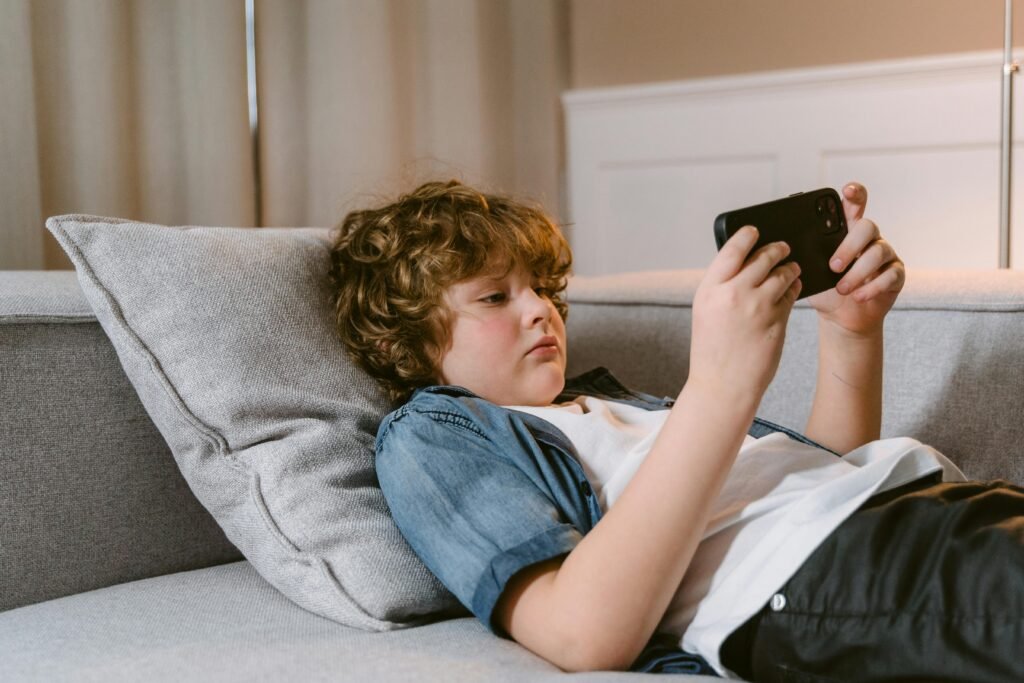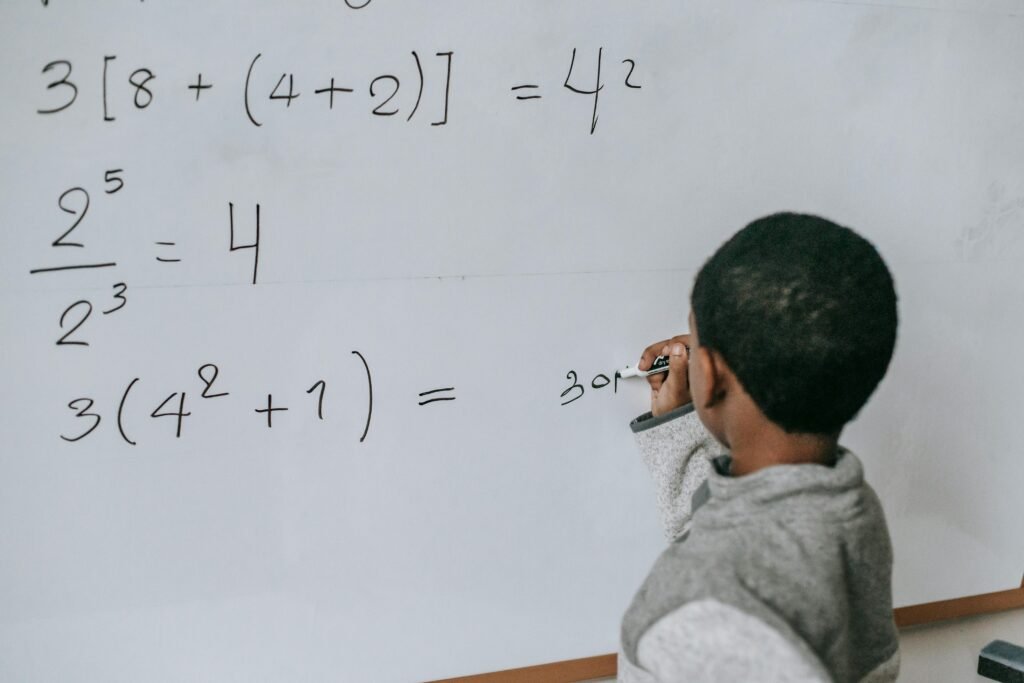Screens are everywhere. They’re in our homes, our pockets, our classrooms, and even in our cars. For kids today, screens are a big part of daily life. But how much is too much? When does screen time cross the line from being helpful and fun, to being something that affects your child’s health, learning, or happiness?
Children aged 8–12 spend an average of 4–6 hours per day on screens
If your child is between 8 and 12 years old, there’s a good chance they’re spending about four to six hours every day looking at a screen. That could be watching YouTube, playing games, using apps, doing homework online, or texting friends. It sounds like a lot because it is. Think about it—if your child is awake for 14 hours a day, nearly half of their free time could be spent on screens.
This number might feel normal now, especially when screens are used for school, talking to friends, or even reading. But what used to be a treat—some screen time here and there—has turned into something kids almost can’t live without.
So, what happens when this much screen time becomes part of their everyday routine?
Too much screen time can mean less time outside. It means less face-to-face conversation, less reading, and less creative play. These are all things that help your child grow in ways that screens can’t. Physical activity, for example, is one of the best ways to boost focus, build strong bones, and even improve sleep. But if a child is spending hours on a tablet or TV, there’s not much time left for movement.
As a parent, you don’t need to cut screens out completely. But finding a better balance is key. You could start by keeping track of how much time your child actually spends on screens each day for one week. You may be surprised by what you find. Use a timer if needed. Talk to your child about the results. Not in a blaming way—but with curiosity. Let them help make a new daily plan.
Create simple rules like no screens during meals, or a 30-minute outdoor play break before using any device. You could also try a screen-free day once a week. It might be tough at first, but kids often discover they enjoy other things more than they thought—like biking, drawing, or just talking with family.
The goal is not to remove screens from your child’s life. The goal is to make sure screens don’t replace the other good stuff.
Teens spend up to 9 hours per day using digital devices
Teenagers are some of the heaviest users of digital devices today. Between smartphones, laptops, gaming consoles, and streaming services, many teens are hitting up to nine hours of screen time a day. That’s more than a full workday—every single day.
This much screen time may seem unavoidable. Teens use devices for schoolwork, socializing, entertainment, and even relaxation. But just because it feels normal doesn’t mean it’s healthy.
Spending this much time on screens can take a toll. Studies show that teens who use screens for long periods often feel more tired, more stressed, and more distracted. They may even struggle with focus in class or lose motivation for things they used to enjoy.
Social media is also a big part of the issue. Scrolling for hours can leave teens feeling left out or not good enough. That constant stream of comparison can affect their self-worth—and it’s happening at an age where identity and confidence are still forming.
If your teen is spending nine hours a day on screens, it’s worth looking closer. Ask them how they feel after long sessions online. Do they feel happy? Or drained? Do they sleep well? Are they still doing the things they love in real life?
Once you start noticing patterns, it’s easier to help them adjust. Encourage digital breaks throughout the day. Suggest setting limits on certain apps using built-in phone tools. For example, iPhones and Androids both have screen-time reports and app timers.
Another helpful idea is creating device-free zones in the house—like the bedroom or the dinner table. This helps your teen connect more with family and sleep better too.
And most importantly, model good habits yourself. If your teen sees you scrolling all night, they’ll feel it’s okay to do the same. But if you put your phone down during dinner or while talking, they’re more likely to follow your lead.
Only 20% of children meet the American Academy of Pediatrics’ screen time guidelines
The American Academy of Pediatrics (AAP) recommends that kids between the ages of 2 and 5 have no more than one hour of high-quality screen time per day. For older kids, they suggest setting consistent limits and making sure screen use doesn’t get in the way of sleep, physical activity, and face-to-face time.
But guess what? Only 1 in 5 kids actually stick to these guidelines. That means most children are getting way more screen time than experts suggest.
Why does this matter? Because those guidelines aren’t random. They’re based on studies about brain development, mental health, and learning.
Too much screen time, especially for younger kids, can slow language development and reduce time spent in active play. Both of these are super important for growing brains.
It’s easy to hand a child a tablet when you need a quiet moment (and that’s totally okay sometimes), but if it becomes the go-to solution for boredom or tantrums, screen habits can get hard to manage.
One way to help is to build a screen-time routine, not just a limit. Think of screen time like a treat—something your child earns after doing other good-for-you things like reading, drawing, helping out, or moving their body. Let your child know when screen time will happen, how long it will last, and what they can use the screen for.
Also, try to co-view when you can. Sit with your child during screen time and talk about what you’re seeing. Ask questions. Laugh together. Make it something shared, not something isolating.
When you treat screens with care—not as a babysitter, but as a tool—you’ll start to see a difference in how your child uses them.
Excessive screen time is linked to 25% higher risk of depression in adolescents
One of the most serious concerns about too much screen time, especially for teens, is its link to mental health. Research shows that adolescents who spend long hours on screens are 25% more likely to develop symptoms of depression.
This doesn’t mean screens cause depression directly. But when screen time replaces sleep, outdoor play, real conversations, or exercise, a teen’s mental health can suffer. Social media can be especially tricky.
It often shows a highlight reel of other people’s lives, making teens feel like they’re missing out or not measuring up.
Also, when kids spend too much time on screens, they often miss the chance to practice handling boredom, solving problems face-to-face, or just relaxing without stimulation. All of these are important for a healthy emotional life.
As a parent, pay attention to mood changes that may follow long stretches of screen use. Is your teen more irritable after scrolling? Do they seem more anxious or tired? These are signs to take seriously.
Encourage screen-free mental breaks. Maybe it’s journaling, walking, or spending time with a pet. These simple things can help the brain reset. Try creating a “wind-down” routine in the evening that avoids screens altogether. Even 30 minutes of no screen time before bed can improve sleep and reduce stress.
Also, have open conversations about how online life makes your teen feel. Let them know it’s okay to take breaks from social media or unfollow accounts that bring them down.
The online world moves fast. But your teen’s mind and heart need space to grow slowly, and safely.
Children who spend more than 2 hours per day on screens show lower scores in language and thinking tests
Imagine your child sitting for a test that measures how well they think, solve problems, or understand language.
Now imagine that their daily screen time may be quietly pulling those scores down. That’s exactly what studies have found—kids who use screens for more than two hours a day tend to do worse on language and cognitive development tests.
The brain is like a muscle. It grows stronger with exercise—and that exercise often comes from reading, storytelling, playing with others, solving puzzles, and asking questions. But when screens take over those moments, the brain doesn’t get the same workout.
Watching shows or videos isn’t bad on its own. Some content is educational and even inspiring. But when it’s passive—when kids are just staring at fast-moving images without thinking deeply—it doesn’t help the brain build strong language or reasoning skills.
Also, too much screen time may crowd out important brain-boosting activities. Reading aloud, having conversations, asking “why” and “how”—these are small things that make a big difference over time.
To support your child’s language and thinking, create a daily routine where screen time is balanced with speaking, listening, reading, and imaginative play.
You could set up “tech-free talk time” each evening, where everyone shares one thing they learned or wondered about during the day. It helps your child think, express themselves, and feel heard.
You could also make the most of screen time by choosing content that encourages thinking. Look for shows or games that ask questions, tell stories, or solve problems. Even better—watch together and talk about it afterward.

Ask your child to explain what they saw or predict what might happen next. That simple act of thinking out loud builds brain power.
Remember, it’s not just about limiting screens—it’s about replacing some of that screen time with richer, deeper brain-building moments.
Screen time over 7 hours daily is associated with thinning of the brain’s cortex
This one is a little scary, but very real. Scientists have found that children who use screens for more than seven hours a day show physical changes in the brain. Specifically, the cortex—the part of the brain that helps with language, memory, and problem-solving—can actually get thinner.
Why does this matter? Because a thinner cortex is linked to lower mental performance. It can make it harder for kids to focus, learn, and remember what they’ve studied.
The brain is still growing and changing well into the teenage years. During that time, it’s especially sensitive to how it’s used. Just like good habits can make it stronger, harmful ones can slow it down.
Seven hours may sound extreme, but it can add up fast. A few hours of schoolwork on a laptop. Some time watching videos. A bit of gaming. A few more hours on social media or texting. It all counts. And when it reaches that point, real damage can happen.
So what can you do? Start by looking at the full day. Where is screen time happening? Can some of it be replaced with hands-on activities like building, drawing, writing, or even chores?
Create a simple rule that no single screen session should last more than an hour without a break. Encourage your child to take “brain breaks”—go for a walk, stretch, talk, drink water, or even close their eyes and rest. These tiny moments help reset the brain and protect it from overstimulation.
It’s also a great idea to fill your home with screen-free zones and brain-building tools. Keep books in easy reach. Set out puzzles. Create a reading nook. These little touches can gently shift your child’s habits without force.
You don’t need to panic or go screen-free overnight. But being mindful of that seven-hour line can protect your child’s brain in big ways over time.
Kids aged 2–5 who exceed 1 hour of screen time daily have 5x more behavioral issues
This one hits home for many parents. Toddlers and preschoolers who spend more than an hour a day on screens are five times more likely to have emotional or behavior problems. That’s a huge increase.
Think about what early childhood is supposed to be. It’s a time for learning how to take turns, how to wait, how to play, how to handle big feelings. These skills come from real-world play and real-world people. But when screens replace these moments, kids don’t get the same practice.
Fast-paced shows, flashy games, and loud sounds can also overwhelm little brains. Kids may look quiet while watching—but inside, they might be overstimulated. When the screen turns off, you might notice tantrums, whining, or wild energy. That’s not bad behavior—it’s their brain trying to come back to balance.
The good news? These issues can improve fast when screen time is reduced. You don’t need to cut out screens completely. But try this: stick to high-quality content, limit time to one hour a day, and make screen time something special—not automatic.
Also, use screens as a shared experience. Sit next to your child and talk about what you’re watching. Ask simple questions like “What happened next?” or “How do you think she felt?” These talks help kids connect stories to real life.
Outside of screen time, offer lots of chances for hands-on play. Playdough, blocks, pretend play, drawing, dancing—these simple things are gold for your child’s brain and behavior.
Most importantly, be patient. Changing screen habits takes time, but the results—calmer moods, better focus, and stronger relationships—are so worth it.
Screen time beyond 2 hours a day is associated with reduced academic performance
It may not be what kids want to hear, but it’s true: more screen time can mean lower grades. Studies show that children who use screens for more than two hours a day outside of school tend to do worse in reading, math, and problem-solving.
Why? It’s not just about the time spent on screens—it’s about what screens are pushing out. Reading gets skipped. Homework gets rushed. Sleep gets cut short. Focus and memory take a hit. All of this adds up.
Think of it this way: the brain can only take in so much each day. When screen time eats up the energy and space that learning needs, grades suffer.
As a parent, you don’t have to become the “no fun” police. But it helps to set up some simple screen rules during school days. For example, make sure homework comes before gaming or videos. Keep devices out of bedrooms so sleep can be deep and undisturbed.
You can also create a clear boundary: no entertainment screens Monday to Thursday. Keep those days focused on learning, rest, and family. Then let the weekends have a little more screen fun. Kids often respond well to structure, especially when they know rewards are coming.
And if you want to make screen time more academic, try mixing in learning apps or documentaries. But still watch the clock. Even the best content can’t replace sleep, reading, and human connection.
Your child doesn’t have to be screen-free to succeed. They just need the right balance—and that starts with you.
45% of parents say screens interfere with sleep for their children
Almost half of parents today say that screens are messing with their child’s sleep. That’s a big deal because sleep is one of the most important things for a growing brain and body.
Sleep isn’t just rest. It’s when learning sticks, emotions settle, and the body repairs itself. But when screens take over the bedtime routine—or worse, are used in bed—kids don’t sleep as well. The blue light from screens tricks the brain into thinking it’s still daytime, so it stops making melatonin, the sleepy hormone. This makes it harder to fall asleep, and even if kids do sleep, the quality of their sleep may be poor.
Also, the content kids watch or play can get their brains all fired up. Even funny or exciting shows can make the brain too alert right before bed. Instead of calming down, the mind stays busy. That leads to tossing, turning, and tired mornings.
If your child is struggling with sleep, check the role screens are playing. Are they watching videos right before bed? Are they sneaking devices under the covers? Is the bedtime routine rushed because of “just five more minutes”?
To help, set a no-screens rule at least one hour before bedtime. Replace screen time with soothing rituals like reading, gentle music, or quiet conversations. Keep devices out of the bedroom if you can—or at least out of reach at night.
You can even model this as a family: have everyone charge their devices outside the bedroom. It’s a small change that sets a big example.
When kids sleep better, everything gets better—mood, focus, energy, even appetite. And it all starts with that evening screen wind-down.
Children who use screens at bedtime are twice as likely to sleep poorly
Here’s another eye-opener: kids who use screens right before bed are twice as likely to have poor sleep. That means more waking up at night, less deep sleep, and more groggy mornings.
This isn’t just about screen time in general—it’s about when screens are used. The bedtime window is crucial. It’s the brain’s chance to power down and prepare for a full night of rest. But if a screen is in front of your child during that time, the brain stays active—and tired kids become cranky, distracted, and even sick more often.
Some kids use screens to fall asleep, thinking it helps them relax. But it actually does the opposite. The flickering light, the excitement, even the simple act of holding the device keeps their brain alert.
If your child depends on a screen to wind down, it’s time to change that habit. Start by gently moving screen time earlier in the evening. Then add relaxing activities that don’t involve a screen—like coloring, puzzles, or soft music.
If they miss the screen at night, try replacing it with a calming audiobook or a sleep story. These still feel engaging, but don’t involve light or movement. And they help the brain shift into rest mode.
Remember: bedtime isn’t just about falling asleep. It’s about how the body stays asleep and how deeply it rests. Removing screens from this time can make a big difference fast.
More than 50% of teens report feeling addicted to their smartphones
Over half of teenagers today say they feel addicted to their phones. That’s a strong word—but it shows just how powerful screens have become in their daily lives.
Phone addiction isn’t just about using the phone a lot. It’s about feeling like you can’t stop using it, even when you want to. It’s about checking it every few minutes, feeling anxious without it, and choosing it over real-life experiences.
Many teens admit they know they’re using their phones too much, but they don’t know how to stop. And honestly, it’s not all their fault. Apps are designed to pull you in and keep you scrolling. Notifications, likes, and streaks are like digital candy—and teens are still learning how to handle that kind of temptation.
As a parent, you can help without being the “bad guy.” Start by talking to your teen—not about the phone itself, but about how they feel using it. Do they feel relaxed? Bored? Anxious? In control? These are powerful questions that can open the door to real change.
You can also help them create “phone-free” times, like during meals, homework, or family time. Encourage simple swaps—like carrying a book or journal instead of a phone, or turning off notifications for non-essential apps.
Another tip: create a “parking spot” for phones during certain hours. It could be a basket in the kitchen or a drawer in the living room. When phones are out of sight, they’re easier to forget.
The goal isn’t to take phones away—it’s to help your teen feel more in control of their own habits. That’s the kind of skill that lasts a lifetime.
Excessive screen time contributes to a 30% increase in attention problems in children
If your child is struggling to focus in school, at home, or even during conversations, screen time could be part of the problem. Studies show that too much screen use is linked to a 30% increase in attention problems, especially in younger kids.
Screens move fast. Videos are short. Games change quickly. Everything happens in an instant. But real life doesn’t work that way. In school, kids need to sit, listen, think, and wait. That’s a very different kind of attention—and it’s one that needs practice.
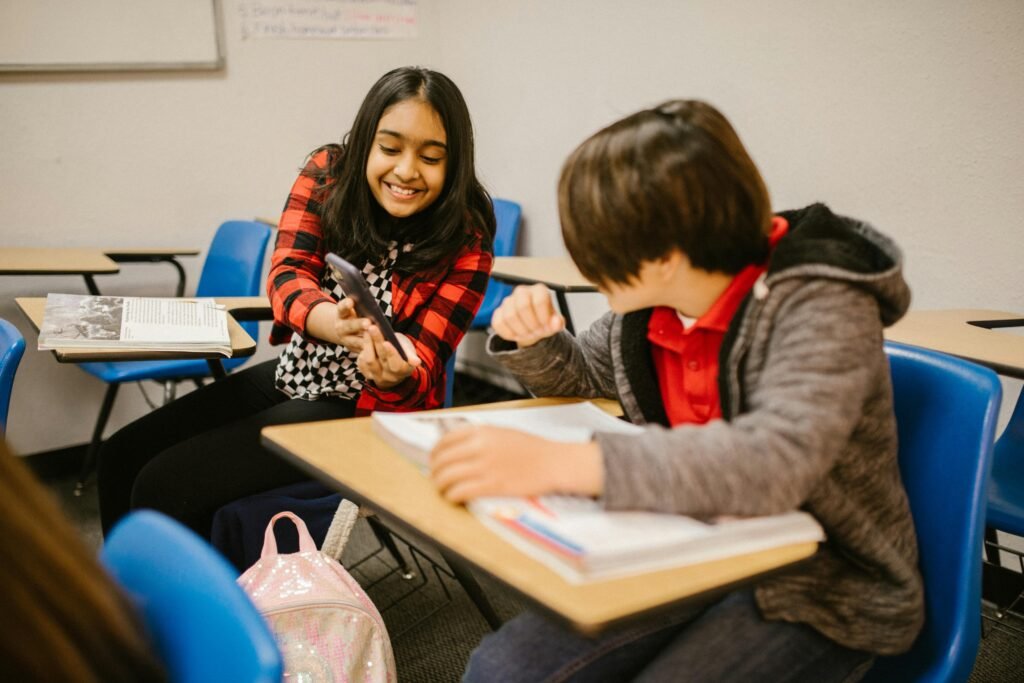
When a child gets used to fast, flashy content, slower-paced tasks (like reading or problem-solving) can feel boring or frustrating. They may zone out, rush through work, or jump from one thing to the next.
To help your child build stronger focus, you can start by making small changes to how and when they use screens. Avoid giving screens during quiet times like meals or car rides. Let their brain practice patience and imagination during these moments.
Also, choose screen content that encourages thinking, not just watching. Educational games, slower-paced stories, or shows with a calm rhythm are great options. These can actually help attention, not hurt it.
And just like with any skill, practice makes progress. Offer plenty of screen-free activities that grow attention. Try puzzles, crafts, building, reading, or simple chores. These quiet tasks may feel small—but they’re like a gym workout for your child’s focus.
You can also model focused behavior yourself. Put down your own phone when you’re talking to your child or helping them with homework. Show them what attention looks like in action.
It may take time, but you’ll start to see your child slow down, stay on task longer, and feel more confident in their thinking.
For every additional hour of screen time, childhood obesity risk increases by 10%
Let’s talk about something you may not connect to screens right away—your child’s weight. Research shows that for every extra hour a child spends on a screen, the risk of obesity goes up by 10%. That’s a pretty steep climb.
Why does this happen? The answer is simple: screen time often means sitting still. Whether it’s TV, video games, or scrolling on a tablet, kids aren’t moving much. Add in a snack or sugary drink, and the body ends up storing more calories than it burns.
Also, many shows and online platforms include ads for junk food. Even if they’re subtle, these messages can shape your child’s food cravings and choices. Suddenly they’re asking for chips or soda—not carrots or water.
But here’s the good news: you can help balance things out, even without cutting screens completely. Start by setting some limits around snack time during screen use. Create a simple family rule like “Only water and fruits during screen time.” This gives your child healthy choices without sounding like a punishment.
You can also add movement breaks between screen sessions. For every 30 minutes of screen use, take 10 minutes to stretch, jump, dance, or walk around the house. Turn it into a game or challenge. Can they do 20 jumping jacks? Can they run around the house before the next episode?
Another idea—try combining screen time with light activity. Let them watch their favorite show while bouncing on a yoga ball or walking on a treadmill. It might sound silly, but even light movement helps the body burn energy and stay healthy.
Most importantly, keep screens out of mealtimes. Eating while distracted often leads to overeating. Instead, use mealtimes to talk, laugh, and connect. These simple changes can help your child maintain a healthy weight—and a healthier relationship with food.
Preschoolers with more than 2 hours of screen time daily have 7.7x higher risk of ADHD symptoms
That’s not a typo—7.7 times higher. When young children have more than two hours of screen time a day, they are almost eight times more likely to show symptoms of ADHD. That’s a major red flag for parents and caregivers.
ADHD isn’t just about being hyper. It’s about trouble focusing, following instructions, sitting still, and managing impulses. These are core skills needed for school success and strong relationships.
So how do screens make it worse? It starts with how the brain reacts to fast-paced, high-stimulation content. It gets flooded with dopamine—the “feel-good” chemical. Over time, the brain gets used to that fast reward. Everything else—school, chores, even simple play—feels boring in comparison.
This doesn’t mean screens cause ADHD. But for children who may already be sensitive, too much screen time can make those challenges much harder to manage.
If your child is struggling with focus or hyperactivity, start with a screen time audit. How much are they really using screens each day? Include TV, tablets, phones, and even smart toys.
Then begin making small changes. Cut back to one hour a day or less. Choose calm, slower-paced content that gives the brain space to think. Avoid screen use within an hour of waking or sleeping. These windows are important for brain resets.
Also, replace screen time with activities that support attention. Try yoga for kids, quiet reading, simple tasks like sorting toys, or games that involve memory and listening.
If your child is receiving support for ADHD, talk to their doctor or therapist about screen habits. They can help you build a plan that supports your child’s brain in every area of life.
Only 26% of parents enforce screen-free times during meals
That means nearly 3 out of 4 families are eating with a screen nearby—whether it’s a TV in the background, a phone on the table, or a tablet used to keep a child quiet. While it might seem harmless, screens during meals actually take away one of the most powerful tools for family bonding and learning: conversation.
Meal times are when kids learn to take turns talking, listen, ask questions, and share how their day went. These small chats build vocabulary, strengthen relationships, and even improve manners. But when a screen takes center stage, those moments are lost.
Also, eating in front of a screen can lead to mindless eating. Kids don’t pay attention to how full they feel, which can lead to overeating or picky habits. Food becomes something to “get through” instead of enjoy.
Want to bring back screen-free meals? Start small. Pick one meal each day—maybe dinner—and turn off all screens during that time. Put phones in another room. Switch off the TV. Set a gentle expectation that this time is for talking and eating only.
Make the table fun. You could play “two truths and a lie,” or ask silly questions like, “If you could eat only one food forever, what would it be?” Keep the mood light and welcoming. Kids are more likely to follow the rule if they enjoy the moment.
And if your child resists at first, don’t give up. It might feel boring at first—but in time, they’ll start looking forward to the real connection they get at the table.
60% of middle schoolers check their phones during class
Yes, even while sitting in front of a teacher, 6 out of 10 middle school students are checking their phones. That’s a major distraction—and one that’s affecting learning all over the world.
It’s not just about missing a few notes. Every time a child checks their phone, it takes the brain about 20 minutes to fully refocus. Multiply that by several checks a day, and you can see how screen distractions are stealing learning time.
What’s worse, it often becomes a habit. A buzz or vibration triggers the hand to reach for the phone—without even thinking. Many kids don’t even realize they’re doing it. And because phones are usually hidden under desks or in laps, teachers may not notice either.
As a parent, you may feel powerless during school hours. But you can still set strong boundaries that help your child build better habits.
Start by talking openly. Ask your child why they check their phone in class. Is it boredom? Anxiety? Social pressure? Understanding the “why” can help you support them better.
You can also use built-in tools to limit access during school hours. Apps like Screen Time (Apple) or Digital Wellbeing (Android) let you lock or limit apps during certain times.
At home, encourage phone-free study times. Create a clear spot for homework that’s free from digital distractions. Use a timer to help your child focus for short bursts—like 25 minutes of work, 5 minutes of rest. This builds the muscle of focus in a world that often pulls it apart.
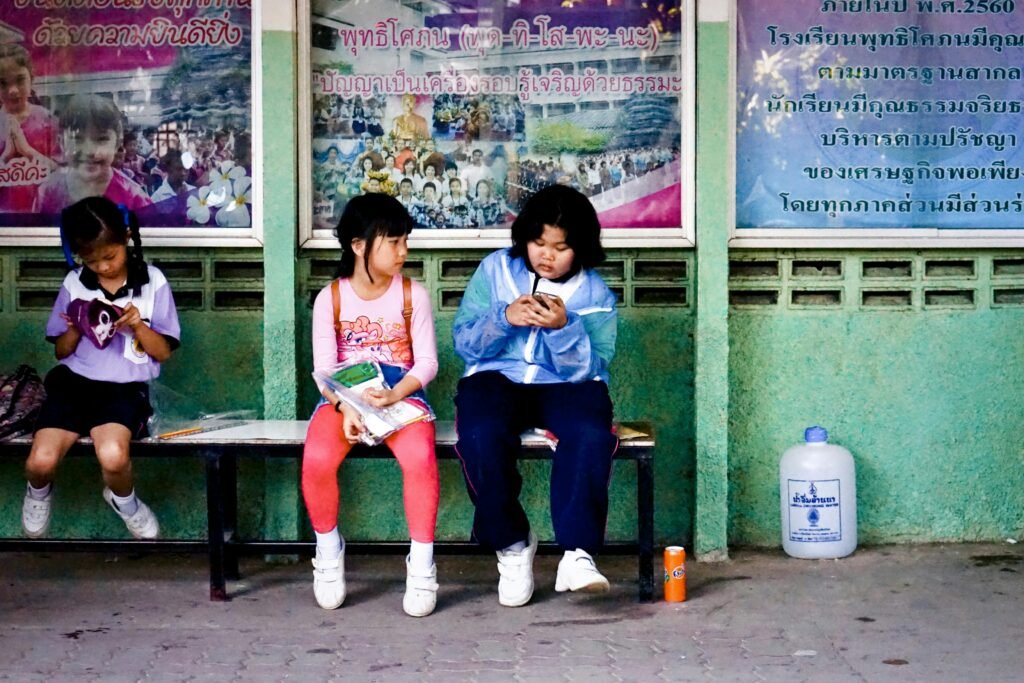
Let your child know you’re not trying to punish them—but protect their focus. Because when they learn to control the screen, instead of letting it control them, they get their power back.
Kids under 8 spend about 35 minutes daily watching online videos alone
Children under 8 are now watching online videos—like YouTube or streaming platforms—for an average of 35 minutes every single day, and they’re usually doing it alone. While that may not seem like much time, it adds up to over 200 hours a year of solo screen watching.
Why does this matter? Because at this age, children learn the most from interaction. They build their understanding of the world through conversations, questions, facial expressions, and body language. When they watch videos alone, those learning moments disappear.
Even if the content is educational, it doesn’t replace human interaction. The child may be watching numbers and letters on screen, but without someone to talk to, those lessons don’t go as deep. And when they’re left to click around alone, they may end up on content that’s not age-appropriate—some of it even harmful.
To fix this, the answer is simple but powerful: watch with them. It doesn’t have to be every time, but when you can, sit down with your child. Ask questions like “What’s happening here?” or “What do you think will happen next?” Talk about what you’re seeing. Laugh together. Learn together.
Also, be choosy about what they watch. Use kid-friendly platforms that filter out ads and unsafe content. Pick short, slow-paced shows that spark imagination or storytelling, not just noise and color.
And don’t forget that 35 minutes doesn’t have to happen every day. Some days can be totally screen-free—and that’s okay! You can replace video time with shared reading, simple crafts, or just good old-fashioned play.
The key isn’t cutting screen time completely. It’s making sure the time they do spend is safe, shared, and smart.
Families with no screen time rules see double the screen use among kids
When there are no clear screen rules at home, kids tend to use devices twice as much as those in homes with some kind of limit. That’s not about strict parenting—it’s about structure. And structure helps kids feel safe, even if they push against it sometimes.
Kids are naturally curious, and screens offer endless stimulation. Without limits, it’s easy for a child to spend hours watching videos, playing games, or jumping from app to app. What starts as a 10-minute break can turn into a 2-hour marathon before you even notice.
If your home doesn’t have screen rules yet, don’t worry. It’s never too late to set some. Start small. You don’t need to ban everything or track every minute. Just begin with 2 or 3 simple rules everyone can follow. Here are a few ideas that work well for many families:
- No screens during meals
- Screens off one hour before bedtime
- Homework first, then screen time
You can write them down and post them where everyone sees them—on the fridge, near the TV, or by the charging station.
Involve your child in the process. Ask them what they think is fair. Give them choices when possible. For example, “Would you rather have screen time before dinner or after?” When kids feel part of the plan, they’re more likely to stick with it.
And be consistent. The rules don’t need to be perfect, but they do need to be followed. If bedtime is at 8, and screens go off at 7, stick to it—even on weekends.
With time, screen rules become habits. And those habits shape how your child uses technology—not just now, but for life.
Teens who use screens more than 3 hours a day are 35% more likely to develop suicidal thoughts
This is one of the hardest facts to read, but also one of the most important. Teens who use screens for over 3 hours a day—especially for social media—are 35% more likely to struggle with suicidal thoughts.
Let’s be clear: screens are not the enemy. But the way they are used can deeply impact mental health. Many teens use social media to stay connected, but it can also make them feel left out, judged, or “less than.” The constant scroll of perfect lives, perfect bodies, and perfect moments can create deep pain.
Add to that the bullying that sometimes happens online—quiet, cruel, and constant—and the screen becomes a place of pressure, not peace.
So what can you do as a parent?
First, be there. Ask your teen how they feel when they’re online. Are there accounts that lift them up? Are there ones that bring them down? Help them unfollow, mute, or block anything that doesn’t feel good. Encourage breaks from social media—real, full breaks. Even a weekend without scrolling can offer relief.
Create a safe space at home to talk about feelings. Let them know it’s okay to say they feel sad, or lost, or unsure. Remind them that these feelings are part of growing up—and that help is always available.
Watch for signs of withdrawal, changes in mood, or sleep problems. These can be signals that something deeper is going on. Don’t wait to reach out to a counselor, teacher, or mental health professional if something feels off.
And finally, lead with love. Your child may roll their eyes, shut their door, or say they’re fine. But deep down, they need to know you see them, hear them, and believe in them—no matter what’s happening on the screen.
70% of teachers say digital distraction is a major problem in classrooms
Teachers are on the front lines of the screen-time battle—and they’re noticing the effects. Seven out of ten teachers say that digital distractions, especially from phones, are a major issue in their classrooms.
Students are zoning out, checking phones under desks, and struggling to stay focused. Even when the lesson is exciting, the pull of the screen is stronger. One message. One game. One scroll. That’s all it takes to break concentration.
What’s more, when one student gets distracted, it can spread. Others look over. The teacher has to stop. Time is lost. Learning suffers.
As a parent, you might think this is out of your hands—but it’s not. What happens at home sets the tone for school.
If your child brings a phone to school, talk with them about when and how to use it. Agree on clear rules like no phone use during class. Practice turning off notifications. Set it to “Do Not Disturb” mode. Encourage them to leave it in their locker or bag during lessons.
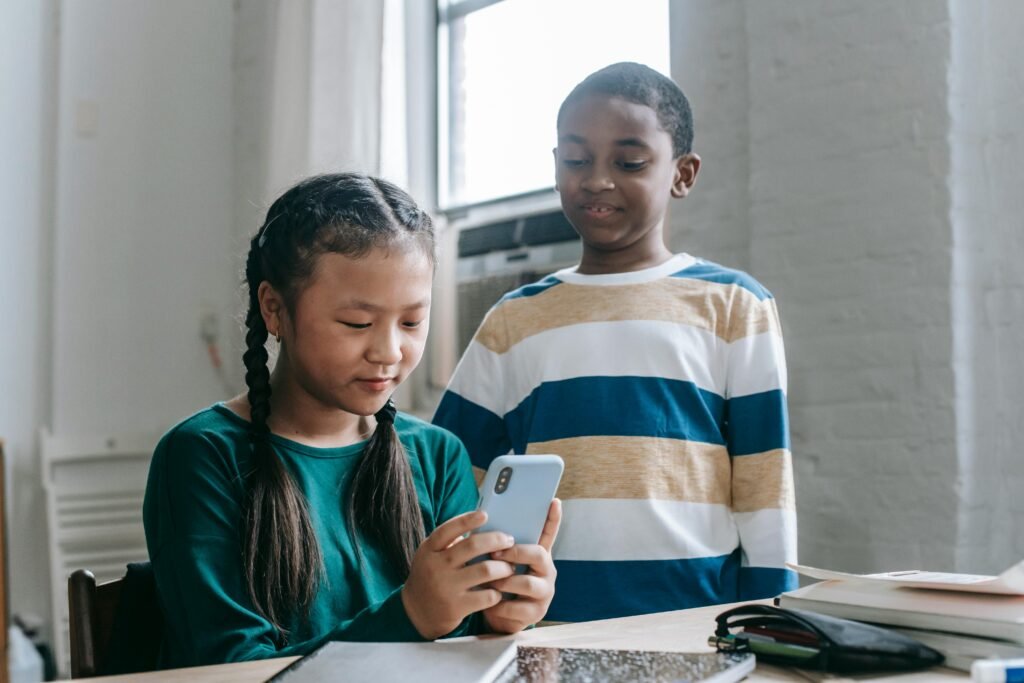
Also, support their focus at home. Create a calm, screen-free homework space. Use timers or soft music to help them build focus. Let them know that the ability to pay attention isn’t just for grades—it’s a life skill.
If your child struggles with attention, work with their teacher. Ask what’s working and what isn’t. See if screen habits at home might be playing a part.
When school and home work together, even big distractions start to shrink.
More than 80% of adolescents use screens within 1 hour of bedtime
Over 80% of teens are using screens right before they go to sleep. That’s a huge number—and it’s not great news. Because when screens sneak into the bedtime routine, they don’t just stay there. They mess with the whole night.
Scrolling, texting, watching, or gaming in bed keeps the brain alert. Blue light from screens blocks melatonin, the hormone that helps the body feel sleepy. It delays sleep and often causes poor-quality rest. The result? Teens wake up groggy, late, and moody—and the cycle repeats the next day.
But this isn’t just about feeling tired. Poor sleep affects everything: learning, mood, memory, appetite, and even self-control. Teens who don’t sleep well are more likely to feel anxious, depressed, or fall behind in school.
So what can you do?
Set a clear boundary: no screens in the hour before bedtime. You could even make it a family rule. Power down all devices at a certain time—say 8:30 or 9:00 p.m.—and create a calming routine instead.
Help your teen set up a better wind-down. Reading, journaling, stretching, music, or just a warm shower can all help. If they use their phone as an alarm, get them a real one. Remove the need for the phone to be in the bedroom at all.
You can also encourage them to charge devices outside the bedroom. Create a central charging station in the kitchen or living room. Make it normal and non-negotiable.
Yes, they’ll resist at first. But after a few nights of better sleep, even they’ll notice the change.
Children exposed to high screen time early in life are more likely to develop anxiety by age 7
This one’s big: kids who get too much screen time in their early years are more likely to show signs of anxiety by the time they’re seven. That’s still so young—but their little brains are already carrying big stress.
Why does this happen? Because screens—especially fast, loud, and non-interactive ones—don’t give kids the same emotional practice as real life does. When they face problems, boredom, or tough feelings, they haven’t learned how to handle them without a screen.
Also, screens often replace the soothing, bonding time with parents or caregivers. If a child watches videos instead of cuddling, reading, or talking, they miss out on those emotional safety nets.
Anxiety in young kids might look like trouble sleeping, constant worry, fear of being away from you, or big tantrums over small things. If your child is showing these signs, it might be time to check their screen habits.
Start small. Cut back on passive screen time—especially YouTube or shows that autoplay endlessly. Replace some of that time with play that uses imagination or movement. Think dress-up, building, drawing, or even helping you cook.
And most importantly, be there emotionally. Sit close. Talk more. Laugh together. These quiet, face-to-face moments are what help kids feel secure.
Reducing early screen exposure doesn’t mean taking away joy. It means giving your child the emotional tools they need to handle life—with or without a screen.
Only 15% of pediatricians report that families follow recommended screen time limits
When doctors ask parents about screen use, only 15% say they follow the official screen time guidelines. That means most families are going beyond what experts say is safe or healthy.
It’s not because parents don’t care. It’s usually because life gets busy, screens feel helpful, and the limits just slip. Kids are happy, quiet, or busy—so it’s easy to let things slide.
But here’s the truth: those guidelines exist for a reason. They’re based on brain science, child development, and years of research. Ignoring them doesn’t make the problems go away—it often just delays them.
So if you feel like screen time has gotten a little out of control, you’re not alone. But there’s always a way back.
Start by learning the current recommendations. For kids 2–5: no more than one hour a day, and co-watch when you can. For older kids: set limits that make sure screens don’t replace sleep, play, homework, or face-to-face time.
Then, look at your family’s screen habits honestly. Are you using screens to calm your child when they’re upset? Are they your go-to for boredom? Is screen time increasing every month?
Make one small change this week. Maybe it’s removing screens from meals. Or turning off devices one hour before bed. Or planning one screen-free afternoon each weekend.
Little steps build stronger habits. And your child’s brain, body, and heart will thank you.
Students who use digital devices in bed lose an average of 1 hour of sleep per night
Let’s look at this from a numbers angle. If your child uses their phone, tablet, or laptop in bed, they are likely losing an hour of sleep every single night. That adds up to 7 hours a week—almost a full night of rest—gone.
That lost sleep has real consequences. It means shorter attention spans, more mood swings, slower learning, and weaker immune systems. Even small sleep loss, when it happens often, builds up into something big.
Why does using screens in bed cause this?
It’s a mix of factors: the light tricks the brain, the content overstimulates, and the device becomes a habit. Even just checking messages or playing a game “for a minute” keeps the mind active long after the screen turns off.
If your child is struggling to fall asleep or waking up tired, check for devices in bed. Are they watching videos under the blanket? Falling asleep with a phone in their hand?
To fix this, create a “bed = sleep” rule. Beds are for resting, not for screens. Set a device curfew. Help your child set up a bedtime routine that doesn’t rely on a phone. This could be reading a book, listening to soft music, or using a nightlight with calming colors.
Give them a place to charge their device that’s not in their room. This one step can improve sleep almost overnight.
Your child’s brain does so much work while they sleep. Give it the rest it needs—and keep screens out of the place where true rest happens.
Daily screen use over 2 hours is associated with a lower GPA by as much as 0.5 points
When kids spend more than two hours a day on screens, their grades often start to dip. In fact, studies show that students with heavy screen use can see their GPA drop by up to 0.5 points. That might not sound like a lot at first—but over time, it really adds up.

Half a grade point could mean the difference between an A and a B. Or getting into a competitive school. Or just feeling confident versus constantly struggling to keep up.
Why does this happen? Because screen time often competes with study time. More time online means less time reading, reviewing notes, or doing homework carefully. Even when students try to multitask—like doing homework while watching a show—they retain less and make more mistakes.
The constant notifications, messages, and quick dopamine hits also train the brain to crave instant reward, which makes it harder to stay focused during slow or challenging tasks—like math problems or reading assignments.
So, what can you do?
First, set clear time blocks for schoolwork that are screen-free. Help your child turn off notifications and put the phone out of reach when it’s time to focus.
Use short bursts of focused work—like the Pomodoro technique: 25 minutes of study, 5 minutes break. It’s great for keeping energy up without burning out.
Make screen time something that happens after school responsibilities are done. It becomes a reward, not a habit.
You can also review weekly grades and assignments together. If something’s slipping, talk about screen use honestly. Is it helping or hurting their goals? Most kids don’t want to fail—they just need support managing their time better.
By making even small changes to screen habits, your child can start to see real improvement in their grades—and in how they feel about school.
Nearly 1 in 3 children under 3 have a personal tablet
Yes, you read that right. Almost one in three toddlers now has their own tablet. That means more children are starting their digital lives before they can even talk in full sentences.
It might seem convenient—tablets keep kids quiet, entertained, or distracted. And for a few minutes here and there, that’s okay. But when toddlers start using tablets as a daily habit, there are long-term concerns.
At this stage, a child’s brain is growing faster than it ever will again. Every touch, word, and smile helps form connections that shape how they think, feel, and learn. But screens don’t give back those rich human responses. They don’t smile back. They don’t ask “Why?” or “How come?”
Kids under 3 learn best through face-to-face play, hearing your voice, touching real objects, and exploring the world around them. When screens take up that space, development can slow down.
So what’s the alternative?
Limit solo screen time. If you do use a tablet, sit with your child and talk about what you’re watching. Make it social, not silent. Choose slow-paced, simple videos with real voices and gentle visuals.
And when possible, swap the screen for a storybook, building blocks, or just playing pretend. These “old-fashioned” tools are still the best learning devices for little kids.
You don’t have to take tablets away completely. But use them like a spice—not the main dish. Because what your toddler really needs is you.
Children who exceed 3 hours/day of screen time are 2x more likely to have emotional challenges
When children go past the three-hour mark on screens daily, they are twice as likely to deal with emotional challenges. That includes things like mood swings, anxiety, frustration, and trouble handling disappointment.
That doesn’t mean screen time causes emotional problems—but it amplifies them.
Here’s why: screens offer fast rewards and constant stimulation. Games always offer a new level. Videos autoplay. Apps are filled with sounds, colors, and instant reactions. That makes regular life feel slow and boring in comparison.
So when the screen turns off, kids can feel restless, grumpy, or even angry. Over time, they may struggle to sit quietly, wait their turn, or deal with everyday ups and downs. They get used to always feeling entertained or in control—and real life doesn’t always work that way.
You can help by teaching your child to pause. Add breaks into screen time. Even a five-minute break between shows or games can help reset the brain.
Offer other outlets for emotions, too. Drawing, journaling, talking, and physical play all help kids release energy and process feelings.
Also, talk about emotions more at home. Ask questions like “What made you feel upset today?” or “How did your body feel when you were nervous?” The more your child understands their feelings, the better they’ll handle them.
And of course, model calm habits yourself. If you’re always on your phone or reacting to it with stress, your child learns to do the same. Show them that emotions can be felt—and managed—without always turning to a screen.
Digital multitasking lowers retention of learning by up to 20%
We’ve all done it—tried to do homework while watching TV, or read while texting. But for kids, this “multitasking” can really hurt. Studies show that switching between tasks on screens can reduce how much they remember by up to 20%.
The brain doesn’t actually do two things at once—it switches quickly between them. And every time it switches, it loses a bit of focus. That’s why multitasking makes learning slower, messier, and more tiring.
So if your child is studying with five tabs open, music playing, and their phone buzzing? Their brain is working way harder than it needs to.
To fix this, help your child work in focused blocks. Choose one task, set a timer (like 20 or 25 minutes), and turn off all other screens or apps. Then take a short break before moving to the next subject.
Create a calm, organized workspace. Remove clutter. Keep only what they need in front of them. Put phones out of reach—or even in another room—until the work is done.
Also, help your child understand that “efficient” doesn’t mean “fast”—it means “focused.” When they learn to work without distraction, they actually finish quicker and remember more.
Focus is a superpower—and it’s one your child can build with the right support.
Over 40% of kids say they feel more stressed after using social media
Social media is supposed to connect people. But for over 40% of kids, it’s doing the opposite—it’s making them feel more stressed.
Why? Because social media is like a nonstop show, and kids are always watching. Who’s posting what? Who’s liking it? Who didn’t like mine? The pressure to be seen, to look good, to fit in—it’s constant.
Even when kids are just scrolling, they’re comparing themselves to others. And they often compare their normal life to someone else’s best moment. That can make anyone feel like they’re not enough.
To protect your child, talk openly about social media. Ask what they like about it—and what makes them feel bad. Help them think critically about what they see. Are those pictures real? Are those people really that happy all the time?
Encourage them to take regular breaks. Even one day a week without social media can help. And remind them: it’s okay to unfollow or mute anyone who makes them feel bad—even if it’s a friend.
You can also set an example. Don’t just scroll during family time. Show your child that joy comes from real moments, not just online likes.
When social media stops feeling fun, it’s time to step back. And your child needs to know that’s okay.
Reducing screen time by just 1 hour daily can lead to a 20% boost in mental well-being
Let’s end on some good news. You don’t have to go screen-free to see results. Just reducing screen time by one hour a day can lead to a 20% boost in a child’s overall mental well-being.
That’s huge. A single hour. That might mean one less show. One less scroll. One earlier bedtime. And in return? Your child feels calmer, happier, and more focused.
So where can you find that hour? It might be in the morning—switch cartoons for music and a slow breakfast. Or in the afternoon—replace some screen time with outside play. Or before bed—choose books instead of a tablet.
Start by tracking your child’s daily screen use. Look for patterns. Then gently choose one block of time to change. Don’t worry if it’s not perfect right away. Progress matters more than perfection.

The power of one hour is real. And it might be the best gift you can give your child today.
Conclusion:
Now that you’ve seen the stats, one thing is clear—screen time isn’t just a small part of your child’s life. It’s shaping how they sleep, how they learn, how they grow, and even how they feel about themselves.
But this isn’t a reason to panic. It’s a reason to take action.
